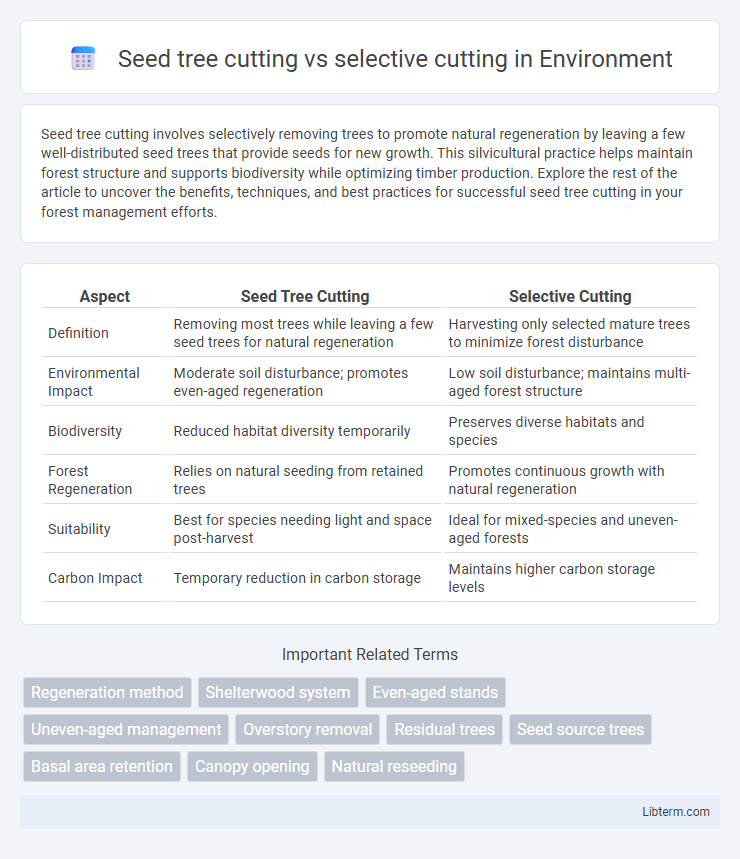Seed tree cutting involves selectively removing trees to promote natural regeneration by leaving a few well-distributed seed trees that provide seeds for new growth. This silvicultural practice helps maintain forest structure and supports biodiversity while optimizing timber production. Explore the rest of the article to uncover the benefits, techniques, and best practices for successful seed tree cutting in your forest management efforts.
Table of Comparison
| Aspect | Seed Tree Cutting | Selective Cutting |
|---|---|---|
| Definition | Removing most trees while leaving a few seed trees for natural regeneration | Harvesting only selected mature trees to minimize forest disturbance |
| Environmental Impact | Moderate soil disturbance; promotes even-aged regeneration | Low soil disturbance; maintains multi-aged forest structure |
| Biodiversity | Reduced habitat diversity temporarily | Preserves diverse habitats and species |
| Forest Regeneration | Relies on natural seeding from retained trees | Promotes continuous growth with natural regeneration |
| Suitability | Best for species needing light and space post-harvest | Ideal for mixed-species and uneven-aged forests |
| Carbon Impact | Temporary reduction in carbon storage | Maintains higher carbon storage levels |
Overview of Seed Tree Cutting
Seed tree cutting is a silvicultural method that involves removing most mature trees from a stand while leaving a few well-distributed seed-producing trees to naturally regenerate the area. This technique promotes even-aged forest regeneration by allowing sufficient sunlight to reach the forest floor, enhancing seedling growth. Seed tree cutting contrasts with selective cutting, which removes individual trees based on criteria such as size or health, aiming to maintain continuous forest cover.
Principles of Selective Cutting
Selective cutting emphasizes the principle of removing only mature or defective trees to promote forest regeneration while preserving overall canopy structure and biodiversity. This method supports continuous forest cover, enhancing soil stability and providing habitats for diverse wildlife species. Seed tree cutting differs by retaining a few seed-producing trees to naturally regenerate the forest, but selective cutting ensures targeted tree removal based on individual tree health and species composition.
Key Differences Between Seed Tree and Selective Cutting
Seed tree cutting involves removing most mature trees in a stand but leaving a few with high seed-producing capacity to regenerate the forest naturally, while selective cutting targets individual trees of varying sizes and ages to promote continuous forest growth and biodiversity. Seed tree cutting often results in even-aged stands with a uniform tree age class, whereas selective cutting maintains uneven-aged stands with diverse tree ages and structures. The primary ecological impact difference lies in seed tree cutting's reliance on natural seeding for regeneration compared to selective cutting's focus on sustained timber production and habitat conservation.
Ecological Impact Comparison
Seed tree cutting preserves key mature trees to promote natural regeneration, enhancing genetic diversity and maintaining habitat structures essential for wildlife. Selective cutting targets specific trees based on species, size, or quality, minimizing soil disturbance and promoting continuous forest cover, which supports biodiversity and ecosystem stability. Both methods influence ecological processes differently, with seed tree cutting favoring regeneration dynamics and selective cutting optimizing forest composition and health over time.
Regeneration Success Rates
Seed tree cutting often results in higher regeneration success rates due to the retention of mature trees that provide ample seed dispersal, promoting natural forest regrowth. Selective cutting, while preserving overall forest structure, may lead to lower regeneration success if seed trees are insufficient or poorly distributed. Effective regeneration in seed tree cutting depends on factors such as seed viability, site conditions, and proper spatial arrangement of retained trees.
Biodiversity Outcomes
Seed tree cutting maintains biodiversity by leaving mature trees scattered to provide seeds for natural regeneration, supporting a variety of wildlife habitats and genetic diversity. Selective cutting enhances biodiversity more effectively by removing specific trees while preserving the overall forest structure, promoting habitat continuity and diverse age classes. Both methods influence biodiversity, but selective cutting typically results in higher habitat complexity and greater species richness.
Suitability for Different Forest Types
Seed tree cutting suits even-aged forest stands, especially coniferous forests, promoting natural regeneration by leaving a few mature trees as seed sources. Selective cutting fits uneven-aged or mixed-species forests, enabling continuous canopy cover and maintaining biodiversity by removing specific trees based on size, species, or health. Each method aligns with forest management goals and ecological conditions, optimizing growth and sustainability for distinct forest types.
Economic Considerations
Seed tree cutting offers economic benefits through reduced operational costs and quicker regeneration, leading to faster timber revenue cycles compared to other methods. Selective cutting, while more expensive due to increased labor and careful tree selection, can sustain higher long-term economic returns by preserving timber quality and promoting continuous forest productivity. Both methods require balancing immediate financial gains with sustained forestry asset value to optimize economic outcomes.
Long-Term Forest Health
Seed tree cutting promotes natural regeneration by retaining a few mature trees that provide seeds, supporting genetic diversity and forest resilience over time. Selective cutting removes individual trees based on specific criteria, minimizing canopy disruption and preserving habitat complexity essential for long-term ecosystem stability. Both methods influence forest structure and species composition, but seed tree cutting more directly supports regeneration processes critical for sustained forest health.
Best Practices for Sustainable Forestry
Seed tree cutting promotes natural regeneration by leaving a few mature trees to provide seeds, ensuring genetic diversity and forest resilience, while selective cutting removes specific trees to maintain continuous canopy cover and minimize ecological disruption. Best practices for sustainable forestry include monitoring site conditions, maintaining species diversity, and implementing cutting cycles that align with growth rates to support habitat integrity and soil conservation. Both methods require adaptive management and careful planning to balance timber production with long-term ecosystem health.
Seed tree cutting Infographic

 libterm.com
libterm.com